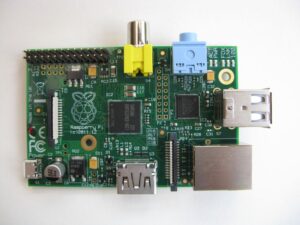There are number of different Raspberry Pi board revisions that have been dispatched since the launch of the Raspberry Pi in 2012.
These different hardware versions are very similar but offer improvements to the design that the Foundation felt would benefit the user community and help the Pi fulfill it’s stated objectives. The main Pi model has always stuck close to the original price of $35.
Model B Revision 1.0

The original board went on sale 29th February 2012 and was manufactured in China.
It was based around a Broadcom BCM2835. This contains an ARM1176JZFS, with floating point, running at 700Mhz, and a Videocore 4 GPU. The GPU was capable of BluRay quality playback, using H.264 at 40MBits/s. It had a fast 3D core accessed using the supplied OpenGL ES2.0 and OpenVG libraries.
The board provided the following features :
- Composite video out
- 3.5mm Audio jack
- Ethernet jack
- HDMI port
- 2 USB ports
- 26 way GPIO header including 17 GPIO, 5V, 3V3 and ground pins
Revision 1.0 + ECN0001
This revision was identical to the original board but with the polyfuses replaced with links and diode D14 removed to improve HDMI connectivity.
Model A
TBA
Model B Revision 2.0

This design was announced 5th September 2012 and was the first version to be manufactured in the UK by Sony. The manufacturing facility is in Pencoed, South Wales.
This revision included a number of important modifications, the significance of which depended on the requirements of the end user.
The main changes included :
- 2 mounting holes added
- 2 pin “reset” header added. Labelled P6
- GPIO21 was replaced with GPIO27 on the main GPIO header, P1
- Resetable polyfuses were removed
- Additional header P5 was added. This made GPIO28, 29, 30 and 31 available as well as providing +5V, +3V3 and two Ground pins
Model B+

On 14th July 2014 the Foundation revealed the B+. This offered a number of improvements over previous designs. The CPU/CPU remained the same as well as the 512MB of RAM.
This is considered the last update to the original Raspberry Pi although an A+ is expected at some point.
The changes included :
- 4 USB Ports
- 40-pin GPIO header
- New combined audio/video 3.5mm jack
- 4 mounting holes
- Rounded PCB corners
- MicroSD card slot
- Connectors on two sides rather than four
Identifying Your Revision
Here are some tips to help you identify your board if you are not sure which one you have.
- If it has 2 USB ports but no mounting holes then it is a Revision 1.0
- If it has 1 USB port and no Ethernet port it is a Model A
- If it has “P5” on the underside just below the 26 way P1 header it is a Revision 2.0
- If it has 4 mounting holes and 4 USB ports it is a Model B+
You can also use the command line to read your hardware revision number.
Or you can use Python to read the hardware revision number.
NOTE : The hardware revision number is not the same thing as the Pi Revision number. Use the table on the Checking Your Raspberry Pi Board Version page to match hardware revision numbers to the Raspberry Pi revision number.


1 Comment
i was lucky enough to get one of the made in china boards. i spent 2 days trying to get it to work. i tried 3 different keyboards and 3 power supplies. to no avail.
it was an actual joy when my new raspberry pi worked straight out of the box yesterday. i am using it to view your site and it seems to handle text based sites fine, infact as fast as my laptop. but sites like ebay make it jam up.
i am planning on using my raspberry pi alongside the ‘radio jove’ radio telescope. it is a project run by nasa and costs $200 foe the equipment.
love your site, going to do a post about it on my site.
http://www.singleboardcomputer.co.uk